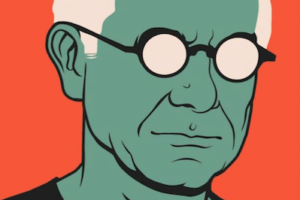|
To see long excerpts from “The History of Rock ’n’ Roll in Ten Songs” at Google Books, click here.
|
“The History of Rock ’n’ Roll in Ten Songs”
A book by Greil Marcus
As Rolling Stone’s first album reviewer, Greil Marcus had few peers and one major precursor: Ralph J. Gleason, who cofounded that magazine, wrote a column for it, and covered popular music for the San Francisco Chronicle and Ramparts magazine. Ranging effortlessly over jazz, blues, folk, pop and rock, Gleason made his difficult craft look easy. Along the way, he wrote liner notes for comedian Lenny Bruce’s albums, testified in Bruce’s San Francisco obscenity trial and landed on President Nixon’s second Enemies List — the only music journalist to achieve that honor.
When Gleason died suddenly in 1975, Marcus wrote his obituary for The Village Voice. By that time, Marcus had left Rolling Stone and recast himself as a cultural historian. That transition began with the book “Mystery Train: Images of America in Rock ’n’ Roll Music” (1975), now in its fifth edition. In a series of loosely connected essays, Marcus claimed that the music of Elvis Presley, the Band, Sly Stone and Randy Newman seemed to “crystallize naturally in visions and versions of America: its possibilities, limits, openings, traps.” The language was pointed — Howlin’ Wolf’s best records, Marcus noted, “came on like three-minute race riots.” The book was an attempt “to broaden the context in which the music is heard: to deal with rock ’n’ roll not as youth culture, or counterculture, but simply as American culture.” In addition to assessing individual artists and their work, Marcus’ purpose was to “discover whose America we are living in at any moment.”
“Mystery Train” helped make the study of popular culture respectable. It did so in part by drawing on Marcus’ graduate training at UC Berkeley. His teachers there — especially Michael Rogin, Jack Schaar and Norman Jacobson — were political scientists by training, but they introduced him to the broader sweep of American history and culture, and it’s a rare Marcus book that doesn’t somehow connect popular music to Melville, Twain, Tocqueville or Puritan theologian Jonathan Edwards. Now, many books later, Marcus writes a column for the literary magazine The Believer, teaches at the New School in New York City and lectures occasionally at elite universities. Despite his academic training and position, he puts little energy into instructing or persuading his readers. Instead, he spins a web of associations around specific songs and flashes across eras and cultural forms in search of connections. His goal isn’t to explain or decode these songs or even to understand their power to thrill him. Rather, he tries to re-create in prose how it might have felt to perform them. His books aren’t known for their reference value; one can plow through long stretches of his work without learning anything except a new way to read.
Nor is Marcus’ associative style built for the long haul. His longest work, “Lipstick Traces: A Secret History of the Twentieth Century” (1989), labored to connect the Sex Pistols to the European avant-garde tradition that claimed Marcus’ attention in the late 1970s and early 1980s. As usual, his politics were close to the surface. He recently described “Lipstick Traces” as his Reagan book and left no doubt about how he regarded his fellow Californian. “I hated Ronald Reagan. … I hated what he did to this country and I hated what he stood for. And I couldn’t bear to look at the country — to seriously, intellectually, grapple with it, critically — in those years.” He later regretted turning his attention away from the American scene during that critical period.
“Mystery Train” and “Lipstick Traces” established Marcus as a shrewd cultural observer, but “The Old, Weird America” (1997) remains his most compelling work. It traced the 1967 Basement Tapes of Bob Dylan and the Band to an “invisible republic” rooted in a southern, agrarian and largely occluded American past. Marcus noted that Harry Smith mapped that terrain in “The Anthology of American Folk Music” (1952), which helped launch the folk revival of the 1950s and early 1960s. Riffing on San Francisco poet Kenneth Rexroth’s notion of the “old, free America,” Marcus probed the anthology’s influence on Dylan’s sensibility and collaboration with the Band. But the influence didn’t stop there; several parts of Todd Haynes’ kaleidoscopic film about Dylan, “I’m Not There” (2007), seemed to grow directly out of the book.
Marcus is forthcoming about his method and style. “I don’t have the ability, or the desire either, to write an extended, coherent, step-by-step argument about something,” he told the Los Angeles Review of Books in 2012. “I like to write through indirection. I like to come in the front door, and while you’re opening the front door, come in the back door, too.” He admitted that his obsession with mystery compels him to seek out “occulted subjects,” or at least to frame his topics that way. And though he marvels at America’s inexhaustible utopian energy, he regards his signature books as anything but optimistic. “I always thought ‘Mystery Train’ was a deeply pessimistic book,” he said, adding that “Lipstick Traces” was “very bitter and defeated.”Despite its subtitle, “Lipstick Traces” wasn’t a secret history of the 20th century; likewise, Marcus’ new book, “The History of Rock ’n’ Roll in Ten Songs,” isn’t a rock history in any conventional sense. Marcus begins by scorning that literary genre, which he claims can be summed up by listing, chronologically, the Rock and Roll Hall of Fame’s inductees. He then proceeds to do just that, filling up the next five pages with their names. With that audacious move, he rejects master narratives and underscores their banality. Rock ’n’ roll isn’t a sequence of formal progressions, he claims, but rather “rediscoveries of a certain spirit, a leap into style, a step out of time.” Its high points are connected only insofar as they manifest rock’s essential spirit. His readers must trust him to detect that spirit and to arrange, like beads on string, the 10 songs that best embody it.
If anyone has earned that trust, it is Marcus. But his apologia is also an example of his indirection. The first two songs — “Shake Some Action” by the Flamin’ Groovies and Joy Division’s “Transmission”– do not seem to capture rock’s essential spirit; indeed, they barely repay our attention. The next number, “In the Still of the Nite” by the Five Satins, is a classic, but Marcus makes almost no effort to justify its selection over other luscious doo-wop ballads. Likewise, two versions of “All I Could Do Was Cry” (by Etta James and Beyoncé Knowles) are beautiful, but how, exactly, do they represent the spirit of rock ’n’ roll? Even as such questions arise, one can feel the breeze from the backdoor; Marcus is already in the house, rifling through the record collection.
The fifth selection, Buddy Holly’s “Crying, Waiting, Hoping,” is more straightforward, and Marcus uses it to explore the historical links among Holly, Dylan and the Beatles. After that chapter, however, he inserts an “instrumental break” about Robert Johnson, the legendary bluesman who died in 1938. The interlude ends with an alternative history of rock ’n’ roll in which Johnson consorts with Louis Armstrong, Big Bill Broonzy, Harold Arlen and Johnny Mercer, Bing Crosby, Johnny Otis, N.W.A., and President Obama, who famously sang a verse of Johnson’s “Sweet Home Chicago” at a White House party. With the possible exception of Otis, none of these artists is usually considered a rock ’n’ roll musician, but by focusing on Johnson’s unique style rather than his sketchy biography, Marcus’ fiction literalizes his claim that the best songs are a step out of time.
The next selections — “Money (That’s What I Want),” “Money Changes Everything” and “This Magic Moment” — allow Marcus to consider Berry Gordy, Motown, the Beatles, Tom Gray, Cyndi Lauper, Lou Reed, Ben E. King, and the Drifters. He then throws another curveball by including Christian Marclay’s “Guitar Drag,” a 14-minute video and album featuring a Fender Stratocaster being dragged behind a pickup truck. That work echoes the 1998 murder of James Byrd Jr. in Jasper, Texas, one of the most vicious hate crimes in recent American history. As he listens to the Stratocaster clattering along the highway, Marcus detects notes of John Lee Hooker’s “John Henry,” Dock Boggs’ “Pretty Polly,” Blind Lemon Jefferson’s “See That My Grave Is Kept Clean,” Johnson’s “Come On in My Kitchen” and Jimi Hendrix’s “The Star-Spangled Banner.”
Byrd was murdered precisely because he was black, and it’s no coincidence that Marcus hears the work of African-Americans artists in “Guitar Drag.” But he also notes Marclay’s interest in recording technology. “Technology captures sound and stamps it on these disks,” Marclay, a former club DJ, said. “They then begin lives of their own. Within these lives, technical cracks — defects — occur. That’s when it gets interesting for me, when technology fails. That’s when I feel the possibility of expression.” For Marcus, “Guitar Drag” is “a scratch in the record — the historical record,” and he explores what that defect tells us about American culture. His attention to such flaws recalls Leonard Cohen’s lyric: “Ring the bells that still can ring/Forget your perfect offering/There is a crack in everything/That’s how the light gets in.”
Marcus’ final selection, “To Know Him Is to Love Him,” features Phil Spector and Amy Winehouse, whose personal crackups might have ended the book on a down note. But their plights are less important than the magic Winehouse conjured in the first few seconds of her 2006 recording of Spector’s song. For Marcus, those moments — and music’s unique capacity to produce them — are more meaningful than a dozen uplifting stories.
Marcus is attracted to songs that seem to come out of nowhere, and “The History of Rock ’n’ Roll in Ten Songs” has that same feel. His essays, like his favorite songs, are provocations. Unlike Gleason, he doesn’t make his work look easy. Impatient with narrative and argument, he strains against the traditional categories of period and genre to produce daring insights rather than tidy stories. His new book isn’t a perfect offering, but its cracks produce a certain slant of light that gives American music a dark and distinctive glow.




You need to be a supporter to comment.
There are currently no responses to this article.
Be the first to respond.